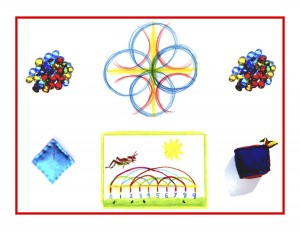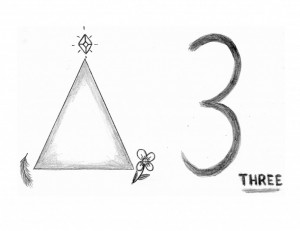Day 72
For one year, 365 days, this blog will address the Common Core Standards from the perspective of creating an alternate, ambient learning environment for math. Ambient is defined as “existing or present on all sides, an all-encompassing atmosphere.” And ambient music is defined as: “Quiet and relaxing with melodies that repeat many times.”
Why ambient? A math teaching style that’s whole and all encompassing, with themes that repeat many times through the years, is most likely to be effective and successful. Because the Common Core Grade 1 Math Standards address addition and subtraction exclusively, they will appear here later, in conjunction with the blocks that focus on the 4 processes. Earlier math blocks focus on meeting the numbers up close and personal through stories, movement, art, form drawing, and hands-on activities like making real numbers. The numbers should come together for calculation only after an in-depth introduction has established them as friendly and personable, so essential for circumventing math fears and phobias!
Before beginning the Grade 1 Common Core Language Arts Standards, just a few words about the story “The Prince in the Black Scarf,” and how Math By Hand relates it to the number 3. Both a related story and a geometric form are chosen for each number. I chose this story for its focus on the family of three: the king, the queen, and the prince. The dynamic of this family relationship is a familiar one, easily accessed by the child(ren) as a reference. This pairing of number and concept is elaborated upon after the story is retold by the child(ren), and helps immeasurably to act as a placeholder for the number 3, making it concrete rather than abstract and thus more accessible and friendly.
I chose the triangle for the number 3, as I chose the square for the number 4, the hexagon for the number 6, etc. Again, this pairing helps for the same reasons cited above, but also acts as a foundation for later concepts in geometry, bringing both the simple numbers and geometry alive by “befriending” them. When art and literature are paired with learning in all subjects, it not only anchors the mundane, abstract concepts in beauty (the native language of the young child), it also helps build a foundation for a life long love of and affinity for learning and the arts. The drawing below interweaves the triangle (geometry) with elements of the story (see the objects at each point of the triangle). Include a more direct illustration for each story as well. For this one, a simple drawing of the king, queen, and prince, captioned in uppercase letters, “THREE IS A FAMILY” would work.
If you read through the whole story the day before yesterday, you know how intricate and complex it is. All elements of literature are embedded in this and other ancient fairy tales. Amazingly, when the story is retold the next day by the child(ten), every nuance is captured, almost word-for-word. At age 6 or 7, the powers of memory are still strong, unlike ours as adults. Conversely, please note that every less than optimal exposure (such as most media) is also deeply and indeed indelibly embedded in the child’s developing brain and consciousness. As characterized by Steiner the fairy tales are “deeply moral.” So that the desirable qualities (justice, fairness, compassion . . .) we might wish to instill in our children are there. They are not directly preached, but subtly conveyed (and this is a crucial difference).
The Common Core Standards if applied as written are most direct, and as such do not (unless very broadly and ambiently interpreted), speak the language of the young child. The original goal of this blog was to ambiently interpret the math standards, but I must expand this to include language arts standards as well, because Waldorf and Waldorf-inspired curriculums are deeply cross-curricular. Today, the first 15 standards (which will appear in blue) will be reviewed, followed by their ambient counterparts (references may be made throughout to “The Prince in the Black Scarf.” Please return to it and review as needed.
Conventions of Standard English:
CCSS ELA-LITERACY L1.1
Demonstrate conventions of standard english grammar and usage when writing and speaking.
CCSS ELA-LITERACY L1.1A
Print all upper and lower case letters.
In Grade 1, captions taken from the story are printed/copied from the teacher’s example by rote, because the letters of the alphabet are being introduced singly and in depth, over the whole year. Slowly and pictorially is key for best learning and absorption because of the abstract nature of reading and writing.
CCSS ELA-LITERACY L1.1B
Use common, proper, and possessive nouns.
In reading and reviewing the story, you will find all of the above in abundance. Now is not the time to pull it apart, but rather the story is left intact with all of its elements, to take root in a more unconscious realm, to be taken up later as in second or third grade formal grammar structure is playfully and artfully taught.
CCSS ELA-LITERACY L1.1C
Use singular and plural nouns with matching verbs in basic sentences (e.g., He hops; We hop).
Basic sentences should be avoided. We often disrespect the wisdom of young children by teaching down to them. The traditional young reader books like the Dick and Jane series or “See Spot Run” are demeaning. If allowed to learn the mechanics slowly, children never need to read boring or condescending content.
CCSS ELA-LITERACY L1.1D
Use personal, possessive, and indefinite pronouns (e.g, I, me, my; they, them, there, anyone, everything).
Again let this occur naturally, in the context of excellently crafted literature. Do not drill these things directly, since “drill and kill” is real. It kills the spirited, creative spirit of curiosity and inquiry nascent in the young child.
CCSS ELA-LITERACY L1.1E
Use verbs to convey as sense of past, present, and future (e.g., Yesterday I walked home; Today I walk home; Tomorrow I will walk home).
This can be accomplished through simple, everyday conversations between teacher or parent and child. If a child is spoken to with correct grammatical structure, s/he will absorb it. And “absorb” is key here, as the most efficient, effective, and painless method of teaching such things. We are losing the glue of human interaction as conversation becomes a lost art, as we devote more and more hours to the digital world.
CCSS ELA-LITERACY L1.1F
Use frequently occurring adjectives.
Reread the little excerpt from “Sylvester and the Magic Pebble.” Steig is a master of the prolific adjective. His books and others like them have complex plots, examples of noble traits, and excellently rich vocabulary, to fill the bill nicely.
CCSS ELA-LITERACY L1.1G
Use frequently occurring conjunctions (e.g., and, but, or, so, because).
Any literature or any good conversation is replete with compound, not simple sentences. Everyday conversations with your child(ren) that honor their native intelligence will have frequently occurring compound sentences, complete with a wealth of conjunctions. You can also be sure to include them and all of these standard requirements in the captions that accompany the story illustrations.
CCSS ELA-LITERACY L1.1H
Use determiners (e.g., articles,demonstratives).
CCSS ELA-LITERACY L1.1I
Use frequently occurring prepositions (e.g., during, beyond, and toward).
These are both easily conveyed with frequent, lively conversation, again most effectively through absorption and osmosis, the way language is learned by the very young.
CCSS ELA-LITERACY L1.1J
Produce and expand complete simple and compound, declarative, interrogative, imperative, and exclamatory sentences in response to prompts.
Much of this is conveyed by inflection when telling stories or when speaking in everyday conversation. The correct punctuation for each type ( . ? ! ) should used in the text written by the teacher and copied by the student(s). Prompts and drills are counterproductive if excessively used.
Conventions of Standard English:
CCSS ELA-LITERACY L1.2
Demonstrate conventions of standard english capitalization, punctuation, and spelling when writing and speaking.
CCSS ELA-LITERACY L1.2A
Capitalize dates and names of people
CCSS ELA-LITERACY L1.2B
Use end punctuation for sentences.
CCSS ELA-LITERACY L1.2C
Use commas in dates and to separate single words in a series.
CCSS ELA-LITERACY L1.2D
Use conventional spelling for words with common spelling patterns and for frequently occurring irregular words.
All of these are taught through imitation at this point, by copying the correctly worded and punctuated text the teacher provides, enabling correct punctuation and spelling to become second nature through exposure and absorption.
CCSS ELA-LITERACY L1.2E
Spell untaught words phonetically, drawing on phonemic awareness and spelling conventions.
“Invented spelling” may not be necessary with enough exposure to correct spelling in copied text and taught word building later on. First, the words are copied correctly, then word building can be taught directly but playfully and artfully in a later grade (through root words and the structure of words).
Knowledge ensues in an environment dedicated to imaginative, creative knowing, where student and teacher alike surrender to the ensuing of that knowledge as a worthy goal. More CCSS LA tomorrow!













